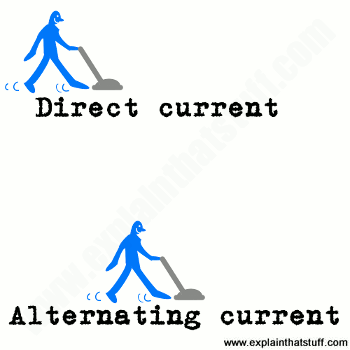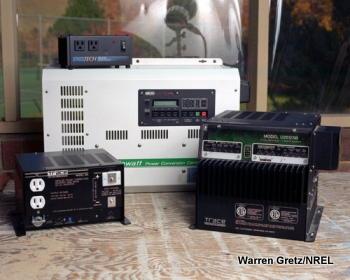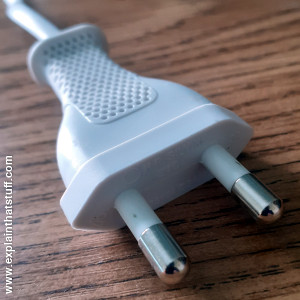
Inverters
by Chris Woodford. Last updated: August 12, 2024.
One of the most significant battles of the 19th century was fought not over land or resources but to establish the type of electricity that powers our buildings.
At the very end of the 1800s, American electrical pioneer Thomas Edison (1847–1931) went out of his way to demonstrate that direct current (DC) was a better way to supply electrical power than alternating current (AC), a system backed by his arch-rival Nikola Tesla (1856–1943). Edison tried all kinds of devious ways to convince people that AC was too dangerous, from electrocuting an elephant to (rather cunningly) supporting the use of AC in the electric chair for administering the death penalty. Even so, Tesla's system won the day and the world has pretty much run on AC power ever since.
The only trouble is, though many of our appliances are designed to work with AC, small-scale power generators often produce DC. That means if you want to run something like an AC-powered gadget from a DC car battery in a mobile home, you need a device that will convert DC to AC—an inverter, as it's called. Let's take a closer look at these gadgets and find out how they work!
Photo: A detail of the electronic circuit inside a power inverter developed at NREL. Photo by Werner Slocum courtesy of US Department of Energy/NREL (DoE/NREL) (photo id #148966).
Sponsored links
Contents
What's the difference between DC and AC electricity?
When science teachers explain the basic idea of electricity to us as a flow of electrons, they're usually talking about direct current (DC). We learn that the electrons work a bit like a line of ants, marching along with packets of electrical energy in the same way that ants carry leaves. That's a good enough analogy for something like a basic flashlight, where we have a circuit (an unbroken electrical loop) linking a battery, a lamp, and a switch and electrical energy is systematically transported from the battery to the lamp until all the battery's energy is depleted.
In bigger household appliances, electricity works a different way. The power supply that comes from the outlet in your wall is based on alternating current (AC), where the electricity switches direction around 50–60 times each second (in other words, at a frequency of 50–60 Hz). It can be hard to understand how AC delivers energy when it's constantly changing its mind about where it's going! If the electrons coming out of your wall outlet get, let's say, a few millimeters down the cable then have to reverse direction and go back again, how do they ever get to the lamp on your table to make it light up?
The answer is actually quite simple. Imagine the cables running between the lamp and the wall packed full of electrons. When you flick on the switch, all the electrons filling the cable vibrate back and forth in the lamp's filament—and that rapid shuffling about converts electrical energy into heat and makes the lamp bulb glow. The electrons don't necessarily have to run in circle to transport energy: in AC, they simply "run on the spot."

Animation: What's the difference between DC and AC electricity? Suppose you have to vacuum a room. Direct current is a bit like working from one side to the other in a straight line; alternating current is like going back and forth on the spot. Both get the job done, albeit in slightly different ways!
What is an inverter?
One of Tesla's legacies (and that of his business partner George Westinghouse, boss of the Westinghouse Electrical Company) is that most of the appliances we have in our homes are specifically designed to run from AC power. Appliances that need DC but have to take power from AC outlets need an extra piece of equipment called a rectifier, typically built from electronic components called diodes, to convert from AC to DC.
An inverter does the opposite job and it's quite easy to understand the essence of how it works. Suppose you have a battery in a flashlight and the switch is closed so DC flows around the circuit, always in the same direction, like a race car around a track. Now what if you take the battery out and turn it around. Assuming it fits the other way, it'll almost certainly still power the flashlight and you won't notice any difference in the light you get—but the electric current will actually be flowing the opposite way. Suppose you had lightning-fast hands and were deft enough to keep reversing the battery 50–60 times a second. You'd then be a kind of mechanical inverter, turning the battery's DC power into AC at a frequency of 50–60 hertz.

Photo: A typical electricity inverter. This one is made by Xantrex/Trace Engineering. Photo by Warren Gretz courtesy of US Department of Energy/NREL (DoE/NREL).
Of course the kind of inverters you buy in electrical stores don't work quite this way, though some are indeed mechanical: they use electromagnetic switches that flick on and off at high speed to reverse the current direction. Inverters like this often produce what's known as a square-wave output: the current is either flowing one way or the opposite way or it's instantly swapping over between the two states:

These kind of sudden power reversals are quite brutal for some forms of electrical equipment. In normal AC power, the current gradually swaps from one direction to the other in a sine-wave pattern, like this:

Electronic inverters can be used to produce this kind of smoothly varying AC output from a DC input. They use electronic components called inductors and capacitors to make the output current rise and fall more gradually than the abrupt, on/off-switching square wave output you get with a basic inverter.
Inverters can also be used with transformers to change a certain DC input voltage into a completely different AC output voltage (either higher or lower) but the output power must always be less than the input power: it follows from the conservation of energy that an inverter and transformer can't give out more power than they take in and some energy is bound to be lost as heat as electricity flows through the various electrical and electronic components. In practice, the efficiency of an inverter is often over 90 percent, though basic physics tells us some energy—however little—is always being wasted somewhere!

Photo: A selection of electricity inverters that can be used with renewable energy generating equipment, such as solar cells and micro-wind turbines. Photo by Warren Gretz courtesy of US Department of Energy/NREL (DoE/NREL).
How does an inverter work?
We've just had a very basic overview of inverters—and now let's go over it again in a little bit more detail.
Imagine you're a DC battery and someone taps you on the shoulder and asks you to produce AC instead. How would you do it? If all the current you produce flows out in one direction, what about adding a simple switch to your output lead? Switching your current on and off, very rapidly, would give pulses of direct current—which would do at least half the job. To make proper AC, you'd need a switch that allowed you to reverse the current completely and do it about 50‐60 times every second. Visualize yourself as a human battery swapping your contacts back and forth over 3000 times a minute. That's some neat fingerwork you'd need!
In essence, an old-fashioned mechanical inverter boils down to a switching unit connected to an electricity transformer. If you've studied our article on transformers, you'll know that they're electromagnetic devices that change low-voltage AC to high-voltage AC, or vice-versa, using two coils of wire (called the primary and secondary) wound around a common iron core. In a mechanical inverter, either an electric motor or some other kind of automated switching mechanism flips the incoming direct current back and forth in the primary, simply by reversing the contacts, and that produces alternating current in the secondary—so it's not so very different from the imaginary inverter I sketched out above. The switching device works a bit like the one in an electric doorbell. When the power is connected, it magnetizes the switch, pulling it open and switching it off very briefly. A spring pulls the switch back into position, turning it on again and repeating the process—over and over again.

Animation: The basic concept of an electromechanical inverter. DC feeds into the primary winding (pink zig-zag wires on the left side) of a toroidal transformer (brown donut), through a spinning plate (red and blue) with criss-cross connections. As the plate rotates, it repeatedly switches over the connections to the primary winding, so the transformer is receiving AC as its input instead of DC. This is a step-up transformer with more windings in the secondary (yellow zig-zag, right-hand side) than the primary, so it boosts a small AC input voltage into a larger AC output. The speed at which the disk rotates governs the frequency of the AC output. Most modern inverters don't work anything like this; this simply illustrates the concept. An inverter set up this way would produce a very rough square wave output.
If you're familiar with the workings of a basic DC electric motor, you'll notice that mechanical inverters like this also have much in common with commutators. Those are the segmented switching devices that allow a simple DC electric motor to keep on spinning in the same direction by periodically reversing its electric current.
Although a very simple mechanical inverter like this would produce a crude square-wave output, it's also possible to produce smoother, more sine-wave-like output in this way as well. In the inverter design below, an ingenious cam-like machine (on the left) uses multiple sets of contacts to progressively add and subtract the outputs from three separate DC batteries, so producing seven different rising and falling voltage levels and a much smoother, almost sine-wave-like output.

Artwork: This mechanical inverter uses a series of rotating cams (red, left) that alternately engage a series of electrical contacts (blue) to add or subtract the voltages from three DC batteries (green), so producing an almost sine-wave-like output at the load (gray, right). Artwork from US Patent US8437159B2: Cam-controlled electromechanical rotary power inverter by Osama Abdulrahman Al-Naseem, University of Kuwait, May 7, 2013.
Sponsored links
Types of inverters
If you simply switch a DC current on and off, or flip it back and forth so its direction keeps reversing, what you end up with is very abrupt changes of current: all in one direction, all in the other direction, and back again. Draw a chart of the current (or voltage) against time and you'll get a square wave. Although electricity varying in that fashion is, technically, an alternating current, it's not at all like the alternating current supplied to our homes, which varies in a much more smoothly undulating sine wave). Generally speaking, hefty appliances in our homes that use raw power (things like electric heaters, incandescent lamps, kettles, or fridges) don't much care what shape wave they receive: all they want is energy and lots of it—so square waves really don't bother them. Electronic devices, on the other hand, are much more fussy and prefer the smoother input they get from a sine wave.

Caption: Nikola Tesla. Although he won the war of the currents, his rival Thomas Edison is still remembered as the pioneer of electric power. Wood engraving of Tesla by Sarong, c.1906, courtesy of US Library of Congress.
This explains why inverters come in two distinct flavors: true/pure sine wave inverters (often shortened to PSW) and modified/quasi sine wave inverters (shortened to MSW). As their name suggests, true inverters use what are called toroidal (donut-shaped) transformers and electronic circuits to transform direct current into a smoothly varying alternating current very similar to the kind of genuine sine wave normally supplied to our homes. They can be used to power any kind of AC appliance from a DC source, including TVs, computers, video games, radios, and stereos.
Modified sine wave inverters, on the other hand, use relatively inexpensive electronics (thyristors, diodes, and other simple components) to produce a kind of "rounded-off" square wave (a much rougher approximation to a sine wave) and while they're fine for delivering power to hefty electric appliances, they can and do cause problems with delicate electronics (or anything with an electronic or microprocessor controller), so, generally, that means they're unsuitable for things like laptops, medical equipment, digital clocks, and smart home devices. Also, if you think about it, their rounded-off square waves are delivering more power to the appliance overall than a pure sine wave (there's more area under a square than a curve). This makes them less efficient and the wasted power, dissipated as heat, means there's some risk of overheating with MSW inverters. On the positive side, they tend to be quite a bit cheaper than true inverters.

Artwork: A modified sine wave (MSW, green) more closely resembles a sine wave (blue) than a square wave (orange), but it still involves sudden, drastic changes in current. The more steps in a modified sine wave, the nearer it approaches the idealized form of a true sine wave.
Although many inverters work as standalone units, with battery storage, that are totally independent from the grid, others (known as utility-interactive inverters or grid-tied inverters) are specifically designed to be connected to the grid all the time; typically they're used to send electricity from something like a solar panel back to the grid at exactly the right voltage and frequency. That's fine if your main objective is to generate your own power. It's not so helpful if you want to be independent of the grid sometimes or you want a backup power source in case of an outage, because if your connection to the grid goes down, and you're not making any electricity of your own (for example, it's night-time and your solar panels are inactive), the inverter goes down too, and you're completely without power—as helpless as you would be whether you were generating your own power or not. For this reason, some people use bimodal or birectional inverters, which can either work in standalone or grid-tied mode (though not both at the same time). Since they have extra bits and pieces, they tend to be more bulky and more expensive.
What are inverters like?
Inverters can be very big and hefty—especially if they have built-in battery packs so they can work in a standalone way. They also generate lots of heat, which is why they have large heat sinks (metal fins) and often cooling fans as well. As you can see from our top photo, typical ones are about as big as a car battery or car battery charger; larger units look like a bit like a bank of car batteries in a vertical stack. The smallest inverters are more portable boxes the size of a car radio that you can plug into your cigarette lighter socket to produce AC for charging laptop computers or cellphones.

Photo: Microinverters are small, compact inverters typically used for converting the DC output of a single photovolatic solar panel into AC that can be fed straight into the power grid. In other words, each panel has its own microinverter. This photo shows six Enphase IQ 6 microinverters under test at the National Renewable Energy Laboratory (NREL). They're Internet-connected, which means you can monitor their performance through your web browser and track how it changes over time. Photo by Dennis Schroeder courtesy of NREL.
Just as appliances vary in the power they consume, so inverters vary in the power they produce. Typically, to be on the safe side, you'll need an inverter rated about a quarter higher than the maximum power of the appliance you want to drive. That allows for the fact that some appliances (such as fridges and freezers or fluorescent lamps) consume peak power when they're first switched on. While inverters can deliver peak power for short periods of time, it's important to note that they're not really designed to operate at peak power for long periods.




